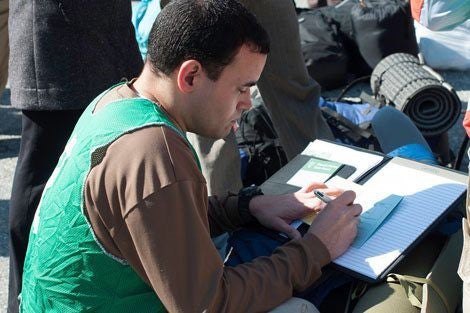
May 15, 2013 — Ninety-three students spent April 26-28, 2013 learning how to rapidly respond to a refugee crisis while being faced with a host of stressful distractions from confrontational child  soldiers to rogue journalists. It was all part of the annual disaster simulation organized by The Lavine Family Humanitarian Studies Initiative, the flagship training and professional development program of the Humanitarian Academy at Harvard. The group included graduate students from Harvard School of Public Health, MIT, and Tufts University, and humanitarian professionals who attended as part of the Academy’s two-week Humanitarian Response Intensive Course.
soldiers to rogue journalists. It was all part of the annual disaster simulation organized by The Lavine Family Humanitarian Studies Initiative, the flagship training and professional development program of the Humanitarian Academy at Harvard. The group included graduate students from Harvard School of Public Health, MIT, and Tufts University, and humanitarian professionals who attended as part of the Academy’s two-week Humanitarian Response Intensive Course.
 For the weekend, Harold Parker State Forest in North Andover, Mass., was transformed into a Sub-Saharan border region beset by extreme weather, food shortages, and militia violence. Students were assigned to teams representing non-governmental organization such as CARE and Save the Children, and worked to develop a plan to provide services for the region’s refugees. The goal of the simulation exercise is to prepare students to work in crisis situations such as the aftermath of the 2010 earthquake in Haiti.
For the weekend, Harold Parker State Forest in North Andover, Mass., was transformed into a Sub-Saharan border region beset by extreme weather, food shortages, and militia violence. Students were assigned to teams representing non-governmental organization such as CARE and Save the Children, and worked to develop a plan to provide services for the region’s refugees. The goal of the simulation exercise is to prepare students to work in crisis situations such as the aftermath of the 2010 earthquake in Haiti.
Photos: Aubrey La Medica
